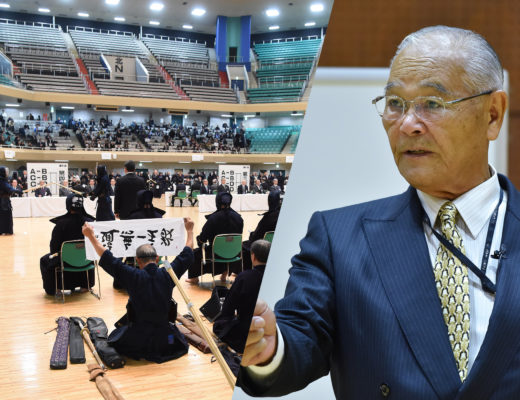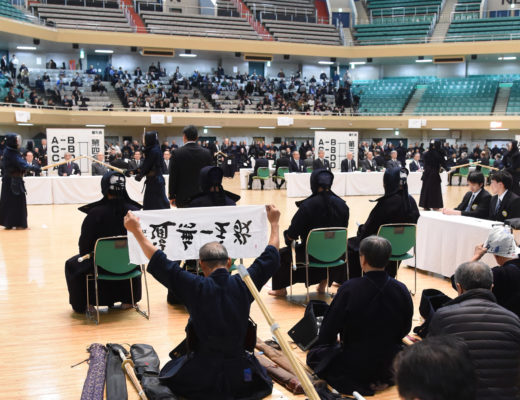2022.10 KENDOJIDAI
Photography: Nishiguchi Kunihiko
Translation: Pepijn Boomgaard
In Kendo, there are three opportunities to strike: a weakness in Kamae, a weakness in movement, and a weakness of the mind. It is said, “If there is no opportunity, create an opening and strike.” What is the technique of seizing the opportunity that is essential for Kendo improvement?
Hayashi Kunio
Born in 1944 in Gifu Prefecture. Emeritus Professor of Chukyo University and Chukyo University Kendo Club Director. Kendo 8th Dan.
Hayashi Sensei emphasizes, “In order to strike when there is an opening, it is also important to let the opponent strike when there is an opening”. Hayashi Sensei, who is still pursuing Kendo as he grows older, introduces the methods he practices to proactively seize an opportunity.
Don’t be outranked. Aim to be correct in 5 areas.
In order to strike when an opportunity presents itself, we must be sufficiently prepared. We must not be swayed by the opponent. Since I was granted 8th Dan, I try to show Kendo that befits an 8th Dan. In order not to embarrass my rank, I try (1) not lose in Seme, (2) not to break my Kamae, and (3) not to be moved. The dictionary defines “rank” as “the grade of a thing, or the refinement of a person or art”. It is the duty of an 8th Dan holder to aim for Kendo that does not compromise dignity. I felt like I had to practice such Kendo. In order not to be outranked*, I aimed for (1) correct posture, (2) correct Kamae, (3) correct breathing, (4) correct Maai and (5) correct awareness.
My former teacher, Kondo Toshio Sensei, through his long years of experience, practice and teaching, emphasized correct posture, correct breathing, and correct awareness as three elements of progress. Also, Yagyu Nobuharu Sensei taught us to with dignity, strike with all our might, and raise our rank when practicing Yagyu Shinkage Ryu. Furthermore, when I passed 8th Dan, I learned the words Shotai Shoyo (long nurturing of the sacred fetus). Based on the teachings of both Sensei, I started to train with the intention of not losing rank. I believe this is what led to me seeking this style of Kendo.
In practice sessions at seminars, in the Tachiai at the Kyoto Enbu Taikai, and in the matches at the Meiji-mura Tournament, I applied kendo with an awareness of winning without being outranked. I also started to apply the same focus to my daily practice.
Later, when I was selected to participate in the 8th Dan Invitational Tournament, a teacher told me, “Your Kendo is of rank.” At a seminar, an instructor told me, “Your Kendo training is of rank.” I also recall that at one of the All Japan Kendo Federation seminars, a Sensei who had observed my practice said. “Your Kendo has an awareness of rank.” I was glad that other people were able to discern my Kendo as “Kendo of rank” and “training of rank”. This made me feel that my training with the mindset of not losing rank was being put into practice.
Be aware of five areas
After reaching 8th Dan, I became aware of the following five items needed to train at your rank.
- Posture/Kamae
Regarding posture/Kamae, I was aware of the mind’s eye, the stomach and the middle of the sole of my feet. I tried to keep my back straight without losing my posture. I was also conscious of this when taking my 8th Dan exam, but after acquiring 8th Dan, I became even more aware of the training needed in order not to be outranked.
The mind’s eye. In accordance with the teaching of Tozan No Metsuke (looking at a far mountain), I tried to look at my opponent down from above in order to broaden my field of vision. When I was practicing competitive Kendo, which is the unison of attack and defense, all I thought about was confronting my opponent, breaking them down with Seme and striking. Therefore, I was pressuring my opponent with my Shinai and stabilizing my posture with a wide stance. This caused my stance to become low and my Kamae to become small. I narrowed the width of my stance and raised my hips, and focussed on confidently staring my opponent down from above.
The middle of the sole of the foot. I tried to put my weight on the entire ball of my left foot without loosening the back of my knee. At first, my calf muscle became tense and painful, but as I kept training, the pain gradually disappeared and my step became sharper and I became able to jump farther. In other words, by narrowing my stance, and changing the stability, I became able to take sharper steps and jump farther.
The rest of this article is only available for Kendo Jidai International subscribers!




